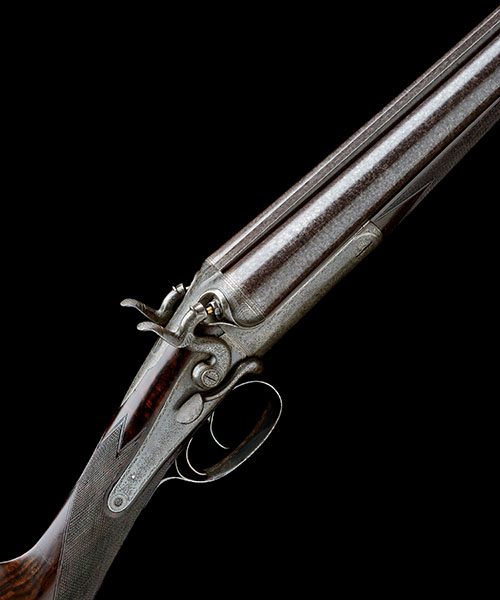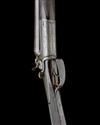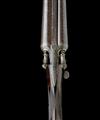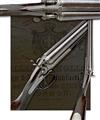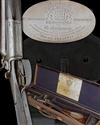Product Details
HOLLAND & HOLLAND
A 12-BORE 1871 PATENT SIDELEVER HAMMERGUN, serial no. 7445, PRESENTED TO W. MONTGOMERY BY THE DUTCH GOVERNMENT FOLLOWING THE SINKING OF THE PRINS FREDERIK,
31in. black powder only bold damascus barrels, rib engraved 'HOLLAND & HOLLAND. 98. NEW BOND STREET. LONDON.', 2 1/2in. chambers, bored approx. true cyl. and 1/2 choke, bore dimensions marginal and left wall thickness below recommended minimum, E.C. Hodges patent action, patent no. 251 of 31st January 1871, use number 988, carved percussion fences, rebounding back-action locks with dolphin hammers, finely engraved with acanthus scrollwork and floral bouquets, retaining traces of original colour-hardening and finish, 14 3/8in. highly figured stock (cracked and with insert repairs at hand), the left side with large oval white metal presentation plaque inscribed with the Netherlands governmental coat of arms and 'HET NEDERLANDSCHE GOUVERNEMENT AAN W. MONTGOMERY TER HERINNERING AAN ZYNE HULPVAARDIGHEID JEGENS DE SCHIPBREUKELINGEN VAN HET NEDERLANDSCHE MAILSCHIP "PRINS FREDERIK" TE FALMOUTH. JUNI EN JULI. 1890.' (presented to W. Montgomery to commemorate his helpfulness during the shipwreck of the Dutch mailship "Prins Frederik" in 1890), weight 7lb. 4oz., in its lightweight leather case
Provenance: The makers have kindly confirmed that the gun was completed in November 1882. No name is listed in the order book.
The 'Prins Frederik' referred to on the presentation plaque refers to the 2,978 tonne iron screw steamer built for the Dutch shipping line Maatschappy Nederland by Glaswegian shipbuilders J. Elder & Co. in 1882.
The mail ship also carried passengers and in June 1890 was en route from Amsterdam to Java, Captained by Klaus Visman, with a full complement of 83 crew, 75 Officers and soldiers of the Dutch Colonial army and 25 civilian passengers. The purpose of the military presence, other than simple transportation to an overseas posting, was likely to be as a guard to the 400,000 silver rijksdaalders - the equivalent to one million Dutch guilders - on board, intended for distribution as army pay to the colonial forces stationed at the core of the Colonial Dutch East Indies.
Having made a short stop at Southampton, the ship headed out towards the Bay of Biscay on the afternoon of the 24th June into increasingly poor weather conditions. At 21:15 hrs on 25th June a catastrophic collision occurred between the fogbound Prins Frederik and a British steamship, the Marpessa, a cargo ship carrying oats and barley with a Captain William Geary at the helm.
The Prins Frederik was struck amidships and sank within just seven to eight minutes. All aboard managed to board the lifeboats bar seven military personnel - a Lieutenant van Wyk and soldiers Kuetz, Rumond, Floury, Marti, Roelvirt and Schifer. The survivors were taken aboard the Marpessa, which despite having her bows stove in, managed to limp back to Falmouth safely.
The High Court of Admiralty in London found against Captain Visman and the Maatschappy company in their judgement on 11th August 1891 - though subsequent investigation has cast severe doubt as to the soundness of their ruling.
The Marpessa, built by Palmers Ship Building & Iron Co. Ltd. in 1889 passed through a number of hands after the incident, was re-named 'Biruta' in 1911. In August 1918 she was torpedoed and sunk 8 miles from the coast of France by an unknown submarine.
Other Notes: The location of the 'Prins Frederik' remains today one of the greatest maritime mysteries, confounding generations of salvage companies and treasure hunters who have tried to locate the wreck and its valuable cargo.
Please click HERE to view Terms & Conditions.
Estimate £2,000-3,000
S2

